Susceptibility Analysis of Land Subsidence along the Transmission Line in the Salt Lake Area Based on Remote Sensing Interpretation
Abstract
:1. Introduction
2. Materials and Methods
2.1. Study Areas
2.2. SAR Datasets
2.3. Land Subsidence Eveluation Index
2.4. Methodology
- Land subsidence database.
- 2.
- Geographic information system.
- 3.
- Land subsidence intensity susceptibility map and validation.
2.5. Time-Series InSAR Process
2.6. Land Subsidence Intensity Classification Based on the K-Means Method
2.7. FR Correlation Analysis
2.8. Multi-Layer Perceptron Neural Network
3. Results
3.1. Land Subsidence Map of SBAS-InSAR
3.2. Deformation of Transmission Lines and Typical Towers
3.3. K-Means Land Subsidence Intensity Classification
3.4. FR
3.5. Land Subsidence Susceptibility Map
3.6. Model Validation
4. Discussion
4.1. Land Subsidence Map of SBAS-InSAR
4.2. Land Subsidence Intensity Classification
4.3. Land Subsidence Susceptibility Map
5. Conclusions
Supplementary Materials
Author Contributions
Funding
Acknowledgments
Conflicts of Interest
References
- Yu, Q.; Ji, Y.; Zhang, Z.; Wen, Z.; Feng, C. Design and research of high voltage transmission lines on the Qinghai-Tibet Plateau-A Special Issue on the Permafrost Power Lines. Cold Reg. Sci. Technol. 2016, 121, 179–186. [Google Scholar] [CrossRef]
- Qi, Z.X.; Wang, X.J.; Liu, C.Q. Analysis on Collapsible Deformation and Prevention Measures of Transmission Line Tower Ground in Qarhan Salt Lake Area. Electr. Power Surv. Des. 2021, 5, 72–76. [Google Scholar]
- Tan, Q.; Man, Y.; Gao, W.; Tong, W.; Zheng, W. Research on design selection analysis and anti-Corrosion treatment of the transmission line tower foundation in Salt Lake area. Power Syst. Clean Energy 2012, 28, 51–56. [Google Scholar]
- Zheng, W.; Man, Y.; Yu, X.; Tan, Q.; Tong, W.; Gong, X.; Liu, Y.; Zhang, J.; Zhu, A. Research on settlement control of the transmission line foundation in Salt Lake area. Power Syst. Clean Energy 2013, 29, 16–19. [Google Scholar]
- Lixin, Y.; Fang, Z.; He, X.; Shijie, C.; Wei, W.; Qiang, Y. Land subsidence in Tianjin, China. Environ. Earth Sci. 2011, 62, 1151–1161. [Google Scholar] [CrossRef]
- Jiang, C. Monitoring and Analysis of Ground Subsidence of East China. In Proceedings of the 2015 International Conference on Management, Education, Information and Control, Shenyang, China, 29–31 May 2015. [Google Scholar]
- Xue, Y.; Zhang, Y.; Ye, S.; Wu, J.; Li, Q. Land subsidence in China. Environ. Geol. 2005, 48, 713–720. [Google Scholar] [CrossRef]
- Fadhillah, M.F.; Achmad, A.R.; Lee, C. Integration of InSAR Time-Series Data and GIS to Assess Land Subsidence along Subway Lines in the Seoul Metropolitan Area, South Korea. Remote Sens. 2020, 12, 3505. [Google Scholar] [CrossRef]
- Galloway, D.L.; Burbey, T.J. Review: Regional land subsidence accompanying groundwater extraction. Hydrogeol. J. 2011, 19, 1459–1486. [Google Scholar] [CrossRef]
- Holzer, T.L.; Galloway, D.L.; Ehlen, J.; Haneberg, W.C.; Larson, R.A. Impacts of land subsidence caused by withdrawal of underground fluids in the United States. In Reviews in Engineering Geology XVI: Humans as Geologic Agents; Geological Society of America: Boulder, CO, USA, 2005; pp. 87–99. [Google Scholar] [CrossRef] [Green Version]
- Lixin, Y.; Jie, W.; Chuanqing, S.; Guo, J.; Yanxiang, J.; Liu, B. Land Subsidence Disaster Survey and Its Economic Loss Assessment in Tianjin, China. Nat. Hazards Rev. 2010, 11, 35–41. [Google Scholar] [CrossRef]
- Liu, J.Y.; Liu, J.H.; Ding, B. Analysis of Subsidence Monitoring of the Saline Soft Soil Ground in Qarham Salt Lake District. Adv. Mater. Res. 2012, 503–504, 1247–1255. [Google Scholar] [CrossRef]
- Wei, Z.Y. Harm of Qinghai Saline Soil to Power Transformation Engineering and Treatment Measure. Qinghai Electr. Power 2007, S1, 40–44. [Google Scholar]
- Fergason, K.C.; Rucker, M.L.; Panda, B.B. Methods for monitoring land subsidence and earth fissures in the Western USA. Proc. Int. Assoc. Hydrol. Sci. 2015, 372, 361–366. [Google Scholar] [CrossRef]
- Abidin, H.Z.; Djaja, R.; Darmawan, D.; Hadi, S.; Akbar, A.; Rajiyowiryono, H.; Sudibyo, Y.; Meilano, I.; Kasuma, M.A.; Kahar, J.; et al. Land Subsidence of Jakarta (Indonesia) and its Geodetic Monitoring System. Nat. Hazards 2001, 23, 365–387. [Google Scholar] [CrossRef]
- Wang, J.; Wang, C.; Zhang, H.; Tang, Y.; Duan, W.; Dong, L. Freeze-Thaw Deformation Cycles and Temporal-Spatial Distribution of Permafrost along the Qinghai-Tibet Railway Using Multitrack InSAR Processing. Remote Sens.-Basel. 2021, 13, 4744. [Google Scholar] [CrossRef]
- Guo, L.; Xie, Y.; Yu, Q.; You, Y.; Wang, X.; Li, X. Displacements of tower foundations in permafrost regions along the Qinghai-Tibet Power Transmission Line. Cold Reg. Sci. Technol. 2016, 121, 187–195. [Google Scholar] [CrossRef]
- Zhang, Z.; Wang, M.; Liu, X.; Wang, C.; Zhang, H.; Tang, Y.; Zhang, B. Deformation feature analysis of Qinghai-Tibet railway using terraSAR-X and sentinel-1A time-series interferometry. IEEE J. Sel. Top. Appl. Earth Obs. Remote Sens. 2019, 12, 5199–5212. [Google Scholar] [CrossRef]
- Ferretti, A.; Prati, C.; Rocca, F. Permanent scatterers in SAR interferometry. IEEE Trans. Geosci. Remote Sens. 2001, 39, 8–20. [Google Scholar] [CrossRef]
- Fobert, M.; Singhroy, V.; Spray, J.G. InSAR Monitoring of Landslide Activity in Dominica. Remote Sens. 2021, 13, 815. [Google Scholar] [CrossRef]
- Zhang, L.; Dai, K.; Deng, J.; Ge, D.; Liang, R.; Li, W.; Xu, Q. Identifying Potential Landslides by Stacking-InSAR in Southwestern China and Its Performance Comparison with SBAS-InSAR. Remote Sens. 2021, 13, 3662. [Google Scholar] [CrossRef]
- Zhou, C.; Cao, Y.; Yin, K.; Wang, Y.; Shi, X.; Catani, F.; Ahmed, B. Landslide Characterization Applying Sentinel-1 Images and InSAR Technique: The Muyubao Landslide in the Three Gorges Reservoir Area, China. Remote Sens. 2020, 12, 3385. [Google Scholar] [CrossRef]
- Li, X.; Yan, L.; Lu, L.; Huang, G.; Zhao, Z.; Lu, Z. Adjacent-Track InSAR Processing for Large-Scale Land Subsidence Monitoring in the Hebei Plain. Remote Sens. 2021, 13, 795. [Google Scholar] [CrossRef]
- Zhou, C.; Gong, H.; Chen, B.; Li, J.; Gao, M.; Zhu, F.; Chen, W.; Liang, Y. InSAR Time-Series Analysis of Land Subsidence under Different Land Use Types in the Eastern Beijing Plain, China. Remote Sens. 2017, 9, 380. [Google Scholar] [CrossRef] [Green Version]
- Han, Y.; Zou, J.; Lu, Z.; Qu, F.; Kang, Y.; Li, J. Ground Deformation of Wuhan, China, Revealed by Multi-Temporal InSAR Analysis. Remote Sens. 2020, 12, 3788. [Google Scholar] [CrossRef]
- Hu, B.; Wang, H.; Sun, Y.; Hou, J.; Liang, J. Long-Term Land Subsidence Monitoring of Beijing (China) Using the Small Baseline Subset (SBAS) Technique. Remote Sens. 2014, 6, 3648–3661. [Google Scholar] [CrossRef] [Green Version]
- Zhou, L.; Guo, J.; Hu, J.; Li, J.; Xu, Y.; Pan, Y.; Shi, M. Wuhan Surface Subsidence Analysis in 2015-2016 Based on Sentinel-1A Data by SBAS-InSAR. Remote Sens. 2017, 9, 982. [Google Scholar] [CrossRef] [Green Version]
- Wang, D.; Liu, J.; Li, X. Numerical Simulation of Coupled Water and Salt Transfer in Soil and a Case Study of the Expansion of Subgrade composed by Saline Soil. Procedia Eng. 2016, 143, 315–322. [Google Scholar] [CrossRef] [Green Version]
- Lai, Y.; Wu, D.; Zhang, M. Crystallization deformation of a saline soil during freezing and thawing processes. Appl. Therm. Eng. 2017, 120, 463–473. [Google Scholar] [CrossRef]
- Wang, W.; Wu, L.; Gong, H.; Fan, P.; Wu, W.; Zhou, Y.; Zhang, Z. Deformation Monitoring for High-Voltage Transmission Lines Using Sentinel-1A Data. IOP Conf. Ser. Earth Environ. Sci. 2019, 252, 32033. [Google Scholar] [CrossRef] [Green Version]
- He, H.; Zhou, L.; Lee, H. Ground Displacement Variation Around Power Line Corridors on the Loess Plateau Estimated by Persistent Scatterer Interferometry. IEEE Access. 2021, 9, 87908–87917. [Google Scholar] [CrossRef]
- Higgins, S.A. Review: Advances in delta-subsidence research using satellite methods. Hydrogeol. J. 2016, 24, 587–600. [Google Scholar] [CrossRef]
- Xiang, W.; Zhang, R.; Liu, G.; Wang, X.; Mao, W.; Zhang, B.; Cai, J.; Bao, J.; Fu, Y. Extraction and analysis of saline soil deformation in the Qarhan Salt Lake region (in Qinghai, China) by the sentinel SBAS-InSAR technique. Geod. Geodyn. 2021, 13, 127–137. [Google Scholar] [CrossRef]
- Hu, B.; Zhou, J.; Wang, J.; Chen, Z.; Wang, D.; Xu, S. Risk assessment of land subsidence at Tianjin coastal area in China. Environ. Earth Sci. 2009, 59, 269–276. [Google Scholar] [CrossRef]
- Guo, Z.; Chen, L.; Yin, K.; Shrestha, D.P.; Zhang, L. Quantitative risk assessment of slow-moving landslides from the viewpoint of decision-making: A case study of the Three Gorges Reservoir in China. Eng. Geol. 2020, 273, 105667. [Google Scholar] [CrossRef]
- Wang, H.; Wang, Y.; Jiao, X.; Qian, G. Risk management of land subsidence in Shanghai. Desalin. Water Treat. 2014, 52, 1122–1129. [Google Scholar] [CrossRef]
- China Federation of Electric Power Enterprises. Code for Design of 110 kv~750 kv Overhead Transmission Line; People’s Publishing House: Beijing, China, 2010. [Google Scholar]
- State Grid Corporation; Northeast Electric Power Design Institute. Design Manual of Power Engineering High Voltage Transmission Lines; China Electric Power Publishing House: Beijing, China, 2003. [Google Scholar]
- Shi, Z. Settlement and treatment scheme of linear self-supporting tower foundation of transmission line in goaf. Shanxi Electr. Power Technol. 1997, 3, 19–21. [Google Scholar]
- Taravatrooy, N.; Nikoo, M.R.; Sadegh, M.; Parvinnia, M. A hybrid clustering-fusion methodology for land subsidence estimation. Nat. Hazards 2018, 94, 905–926. [Google Scholar] [CrossRef] [Green Version]
- Zhang, Y.; Du, L.; Liu, J. Identifying the reuse patterns of coal mining subsidence areas: A case-study of Jixi City (China). Land Degrad. Dev. 2021, 32, 4858–4870. [Google Scholar] [CrossRef]
- Sarmin, F.J.; Zaman, M.S.U.; Sarkar, A.R. Monitoring land deformation due to groundwater extraction using Sentinel-1 satellite images: A case study from Chapai Nawabgonj, Bangladesh. In Proceedings of the 2020 23rd International Conference on Computer and Information Technology, Dhaka, Bangladesh, 19–21 December 2020; pp. 1–6. [Google Scholar]
- Rahmati, O.; Falah, F.; Naghibi, S.A.; Biggs, T.; Soltani, M.; Deo, R.C.; Cerdà, A.; Mohammadi, F.; Tien Bui, D. Land subsidence modelling using tree-based machine learning algorithms. Sci. Total Environ. 2019, 672, 239–252. [Google Scholar] [CrossRef]
- Tien Bui, D.; Shahabi, H.; Shirzadi, A.; Chapi, K.; Pradhan, B.; Chen, W.; Khosravi, K.; Panahi, M.; Bin Ahmad, B.; Saro, L. Land Subsidence Susceptibility Mapping in South Korea Using Machine Learning Algorithms. Sensors 2018, 18, 2464. [Google Scholar] [CrossRef] [Green Version]
- Arabameri, A.; Saha, S.; Roy, J.; Tiefenbacher, J.P.; Cerda, A.; Biggs, T.; Pradhan, B.; Thi, N.P.; Collins, A.L. A novel ensemble computational intelligence approach for the spatial prediction of land subsidence susceptibility. Sci. Total Environ. 2020, 726, 138595. [Google Scholar] [CrossRef]
- Elmahdy, S.I.; Mohamed, M.M.; Ali, T.A.; Abdalla, J.E.; Abouleish, M. Land subsidence and sinkholes susceptibility mapping and analysis using random forest and frequency ratio models in Al Ain, UAE. Geocarto Int. 2022, 37, 315–331. [Google Scholar] [CrossRef]
- Lee, S.; Park, I.; Choi, J. Spatial Prediction of Ground Subsidence Susceptibility Using an Artificial Neural Network. Environ. Manag. 2012, 49, 347–358. [Google Scholar] [CrossRef] [PubMed]
- Pradhan, B. A comparative study on the predictive ability of the decision tree, support vector machine and neuro-fuzzy models in landslide susceptibility mapping using GIS. Comput. Geosci. 2013, 51, 350–365. [Google Scholar] [CrossRef]
- Mohammady, M.; Pourghasemi, H.R.; Amiri, M. Land subsidence susceptibility assessment using random forest machine learning algorithm. Environ. Earth Sci. 2019, 78, 1–12. [Google Scholar] [CrossRef]
- Abdollahi, S.; Pourghasemi, H.R.; Ghanbarian, G.A.; Safaeian, R. Prioritization of effective factors in the occurrence of land subsidence and its susceptibility mapping using an SVM model and their different kernel functions. Bull. Eng. Geol. Environ. 2019, 78, 4017–4034. [Google Scholar] [CrossRef]
- Hakim, W.; Achmad, A.; Lee, C. Land Subsidence Susceptibility Mapping in Jakarta Using Functional and Meta-Ensemble Machine Learning Algorithm Based on Time-Series InSAR Data. Remote Sens. 2020, 12, 3627. [Google Scholar] [CrossRef]
- Ranjgar, B.; Razavi-Termeh, S.V.; Foroughnia, F.; Sadeghi-Niaraki, A.; Perissin, D. Land Subsidence Susceptibility Mapping Using Persistent Scatterer SAR Interferometry Technique and Optimized Hybrid Machine Learning Algorithms. Remote Sens. 2021, 13, 1326. [Google Scholar] [CrossRef]
- Jin, B.; Yin, K.; Gui, L.; Zhao, B.; Guo, B.; Zeng, T. Based on remote sensing interpretation of transmission line tower land subsidence susceptibility evaluation in Salt Lake area. Earth Sci. 2022, accepted. [Google Scholar]
- Li, G.; Tan, Q.; Xie, C.; Fei, X.; Ma, X.; Zhao, B.; Ou, W.; Yang, Z.; Wang, J.; Fang, H. The Transmission Channel Tower Identification and Landslide Disaster Monitoring Based on InSAR. Int. Arch. Photogramm. Remote Sens. Spat. Inf. Sci. 2018, XLII-3, 807–813. [Google Scholar] [CrossRef] [Green Version]
- Yunjun, Z.; Fattahi, H.; Amelung, F. Small baseline InSAR time series analysis: Unwrapping error correction and noise reduction. Comput. Geosci. 2019, 133, 104331. [Google Scholar] [CrossRef] [Green Version]
- Floris, M.; Fontana, A.; Tessari, G.; Mulè, M. Subsidence Zonation Through Satellite Interferometry in Coastal Plain Environments of NE Italy: A Possible Tool for Geological and Geomorphological Mapping in Urban Areas. Remote Sens. 2019, 11, 165. [Google Scholar] [CrossRef] [Green Version]
- Pepe, A.; Bonano, M.; Zhao, Q.; Yang, T.; Wang, H. The Use of C-/X-Band Time-Gapped SAR Data and Geotechnical Models for the Study of Shanghai’s Ocean-Reclaimed Lands through the SBAS-DInSAR Technique. Remote Sens. 2016, 8, 911. [Google Scholar] [CrossRef] [Green Version]
- Ren, H.; Feng, X. Calculating vertical deformation using a single InSAR pair based on singular value decomposition in mining areas. Int. J. Appl. Earth Obs. 2020, 92, 102115. [Google Scholar] [CrossRef]
- Sousa, J.J.; Hooper, A.J.; Hanssen, R.F.; Bastos, L.C.; Ruiz, A.M. Persistent Scatterer InSAR: A comparison of methodologies based on a model of temporal deformation vs. spatial correlation selection criteria. Remote Sens. Environ. 2011, 115, 2652–2663. [Google Scholar] [CrossRef]
- MacQueen, J. Some Methods for Classification and Analysis of Multivariate Observations. Proc. 5th Berkeley Symp. Math. Stat. Probability 1967, 4, 281–297. [Google Scholar]
- Liu, S.; Yin, K.; Zhou, C.; Gui, L.; Liang, X.; Lin, W.; Zhao, B. Susceptibility Assessment for Landslide Initiated along Power Transmission Lines. Remote Sens. 2021, 13, 5068. [Google Scholar] [CrossRef]
- Oh, H.; Pradhan, B. Application of a neuro-fuzzy model to landslide-susceptibility mapping for shallow landslides in a tropical hilly area. Comput. Geosci. 2011, 37, 1264–1276. [Google Scholar] [CrossRef]
- He, S.; Pan, P.; Dai, L.; Wang, H.; Liu, J. Application of kernel-based Fisher discriminant analysis to map landslide susceptibility in the Qinggan River delta, Three Gorges, China. Geomorphology 2012, 171–172, 30–41. [Google Scholar] [CrossRef]
- Pourghasemi, H.R.; Beheshtirad, M. Assessment of a data-driven evidential belief function model and GIS for groundwater potential mapping in the Koohrang Watershed, Iran. Geocarto Int. 2015, 30, 662–685. [Google Scholar] [CrossRef]
- Bianchini, S.; Solari, L.; Del Soldato, M.; Raspini, F.; Montalti, R.; Ciampalini, A.; Casagli, N. Ground Subsidence Susceptibility (GSS) Mapping in Grosseto Plain (Tuscany, Italy) Based on Satellite InSAR Data Using Frequency Ratio and Fuzzy Logic. Remote Sens. 2019, 11, 2015. [Google Scholar] [CrossRef] [Green Version]
- Xiao, Y.; Hao, Q.; Luo, Y.; Wang, S.; Dang, X.; Shao, J.; Huang, L. Origin of brines and modern water circulation contribution to Qarhan Salt Lake in Qaidam basin, Tibetan plateau. E3S Web Conf. 2019, 98, 12025. [Google Scholar] [CrossRef]
- Guo, Z.; Yin, K.; Huang, F.; Fu, S.; Zhang, W. Evaluation of landslide susceptibility based on landslide classification and weighted frequency ratio model. Chin. J. Rock Mech. Eng. 2019, 38, 287–300. [Google Scholar]
- Guo, Z.Z.; Yin, K.L.; Fu, S. Evaluation of Landslide Susceptibility Based on GIS and WOE-BP Model. Earth Sci. 2019, 44, 4299–4312. [Google Scholar]
- Buscema, M. A brief overview and introduction to artificial neural networks. Subst. Use Misuse 2002, 37, 1093–1148. [Google Scholar] [CrossRef] [PubMed]
- Fawcett, T. An introduction to ROC analysis. Pattern Recogn. Lett. 2006, 27, 861–874. [Google Scholar] [CrossRef]
- Kadavi, P.; Lee, C.; Lee, S. Application of Ensemble-Based Machine Learning Models to Landslide Susceptibility Mapping. Remote Sens. 2018, 10, 1252. [Google Scholar] [CrossRef] [Green Version]
- Li, L.; Ni, W.; Li, T.; Zhou, B.; Qu, Y.; Yuan, K. Influences of anthropogenic factors on lakes area in the Golmud Basin, China, from 1980 to 2015. Environ. Earth Sci. 2020, 79, 1–14. [Google Scholar] [CrossRef]
- Li, R.; Liu, C.; Jiao, P.; Liu, W.; Wang, S. The present situation, existing problems, and countermeasures for exploitation and utilization of low-grade potash minerals in Qarhan Salt Lake, Qinghai Province, China. Carbonates Evaporites 2020, 35, 1–11. [Google Scholar] [CrossRef]
- Smith, R.; Knight, R. Modeling land subsidence using InSAR and airborne electromagnetic data. Water Resour. Res. 2019, 55, 2801–2819. [Google Scholar] [CrossRef] [Green Version]
- Mukherjee, S.; Su, G.; Cheng, I. Adaptive Dithering Using Curved Markov-Gaussian Noise in the Quantized Domain for Mapping SDR to HDR Image; Springer International Publishing: Cham, Switzerland, 2018; pp. 193–203. [Google Scholar]
- Miao, F.; Wu, Y.; Li, L. Weakening laws of slip zone soils during wetting-drying cycles based on fractal theory: A case study in the Three Gorges Reservoir (China). Acta Geotech. 2020, 15, 1909–1923. [Google Scholar] [CrossRef]
- Zhang, Z.; Wang, C.; Wang, M.; Wang, Z.; Zhang, H. Surface Deformation Monitoring in Zhengzhou City from 2014 to 2016 Using Time-Series InSAR. Remote Sens. 2018, 10, 1731. [Google Scholar] [CrossRef] [Green Version]
- Miao, F.; Wu, Y.; Xie, Y. Prediction of landslide displacement with step-like behavior based on multialgorithm optimization and a support vector regression model. Landslides 2018, 15, 475–488. [Google Scholar] [CrossRef]
- Zeng, T.; Jiang, H.; Liu, Q.; Yin, K. Landslide Displacement Prediction Based on Variational Mode Decomposition and Mic-Gwo-Lstm Model. Stoch. Environ. Res. Risk Assess. 2022, 36, 1353–1372. [Google Scholar] [CrossRef]
- Miao, F.; Wu, Y.; Török, Á.; Li, L.; Xue, Y. Centrifugal model test on a riverine landslide in the Three Gorges Reservoir induced by rainfall and water level fluctuation. Geosci. Front. 2022, 13, 101378. [Google Scholar] [CrossRef]
- Zeng, T.; Yin, K.; Jiang, H. Groundwater level prediction based on a combined intelligence method for the Sifangbei landslide in the Three Gorges Reservoir Area. Sci. Rep. 2022, 1, 11108. [Google Scholar] [CrossRef]
- Zheng, M. Resources and eco-environmental protection of Salt Lakes in China. Environ. Earth Sci. 2011, 64, 1537–1546. [Google Scholar] [CrossRef]
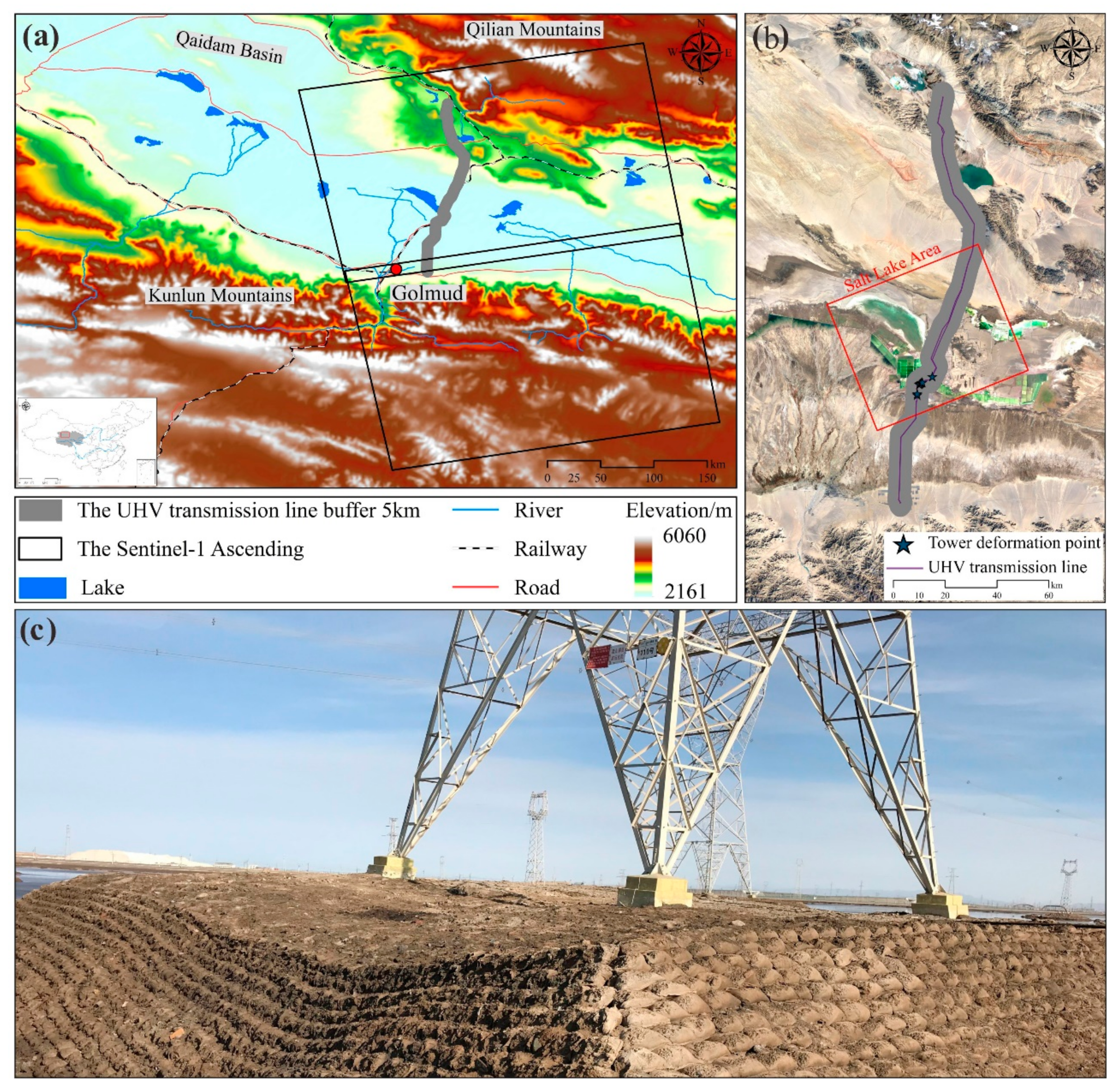
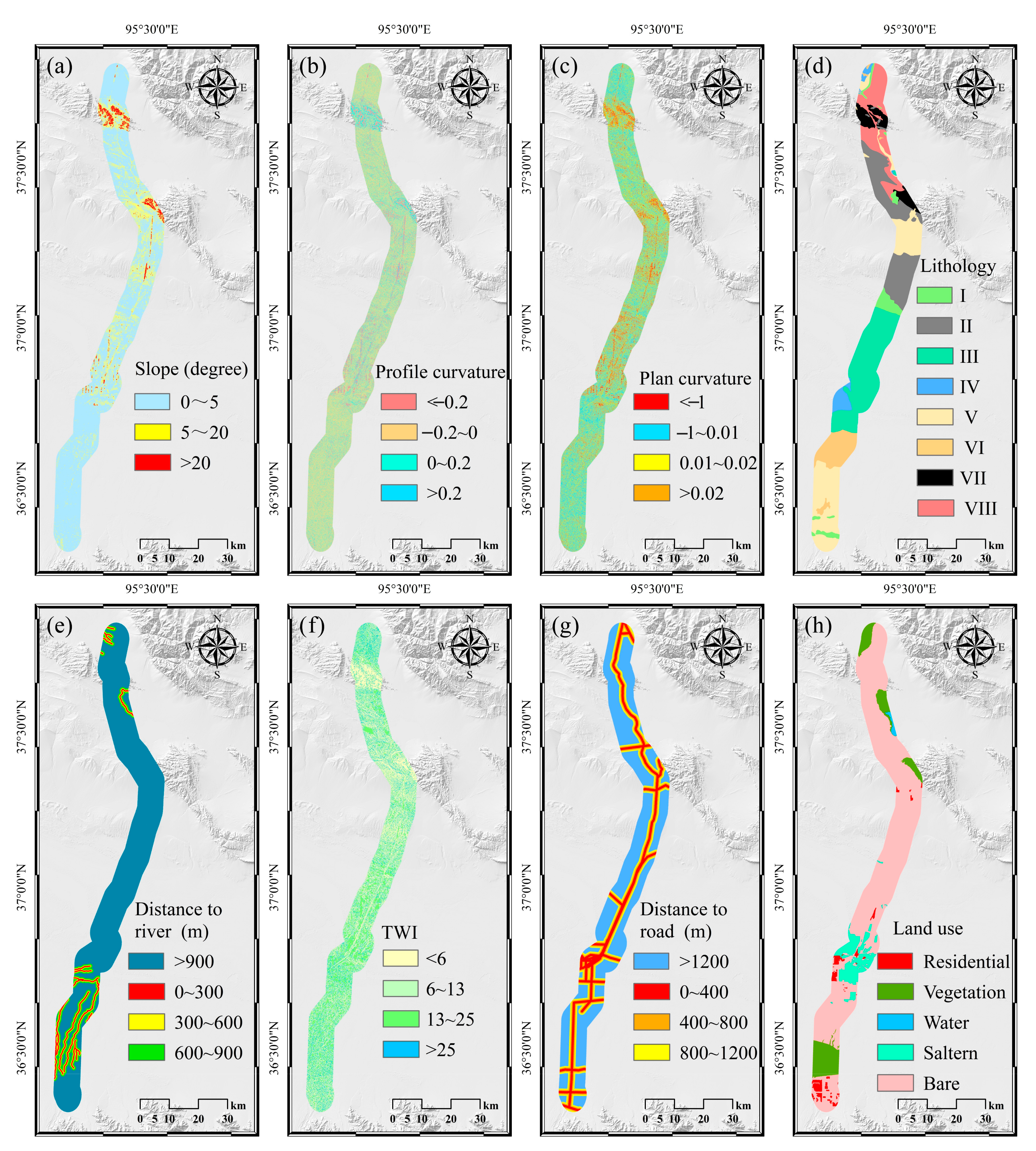
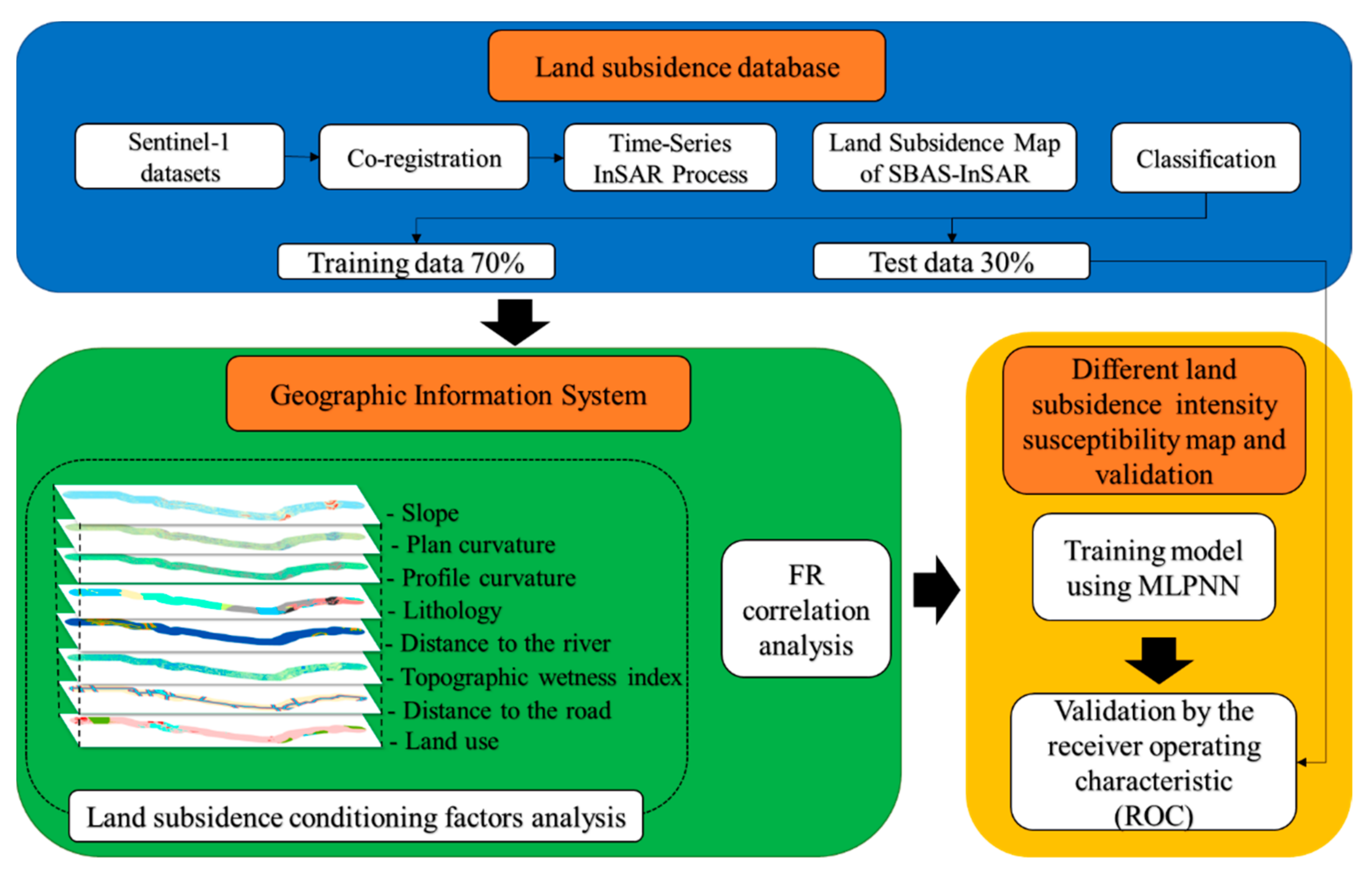

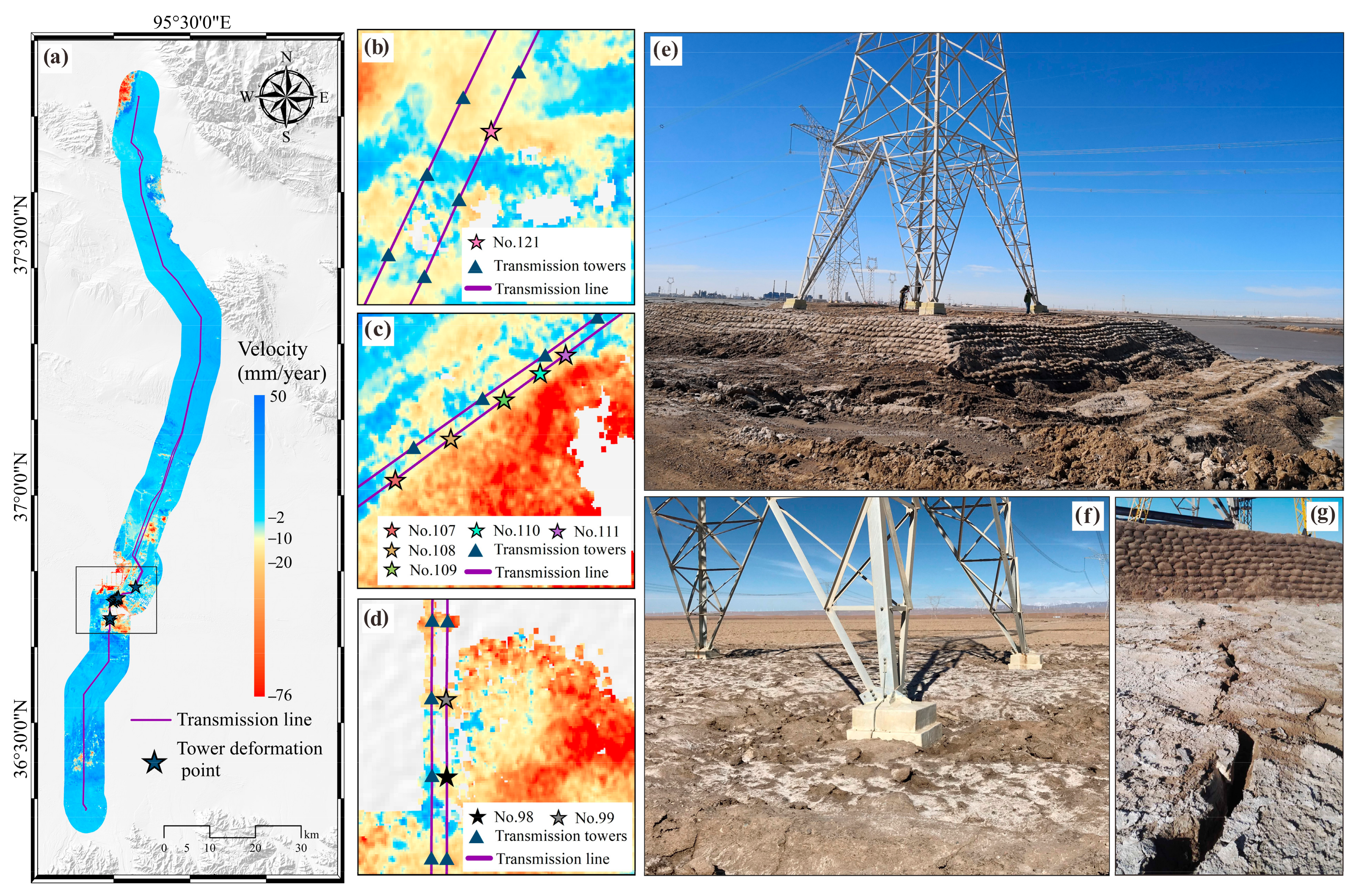
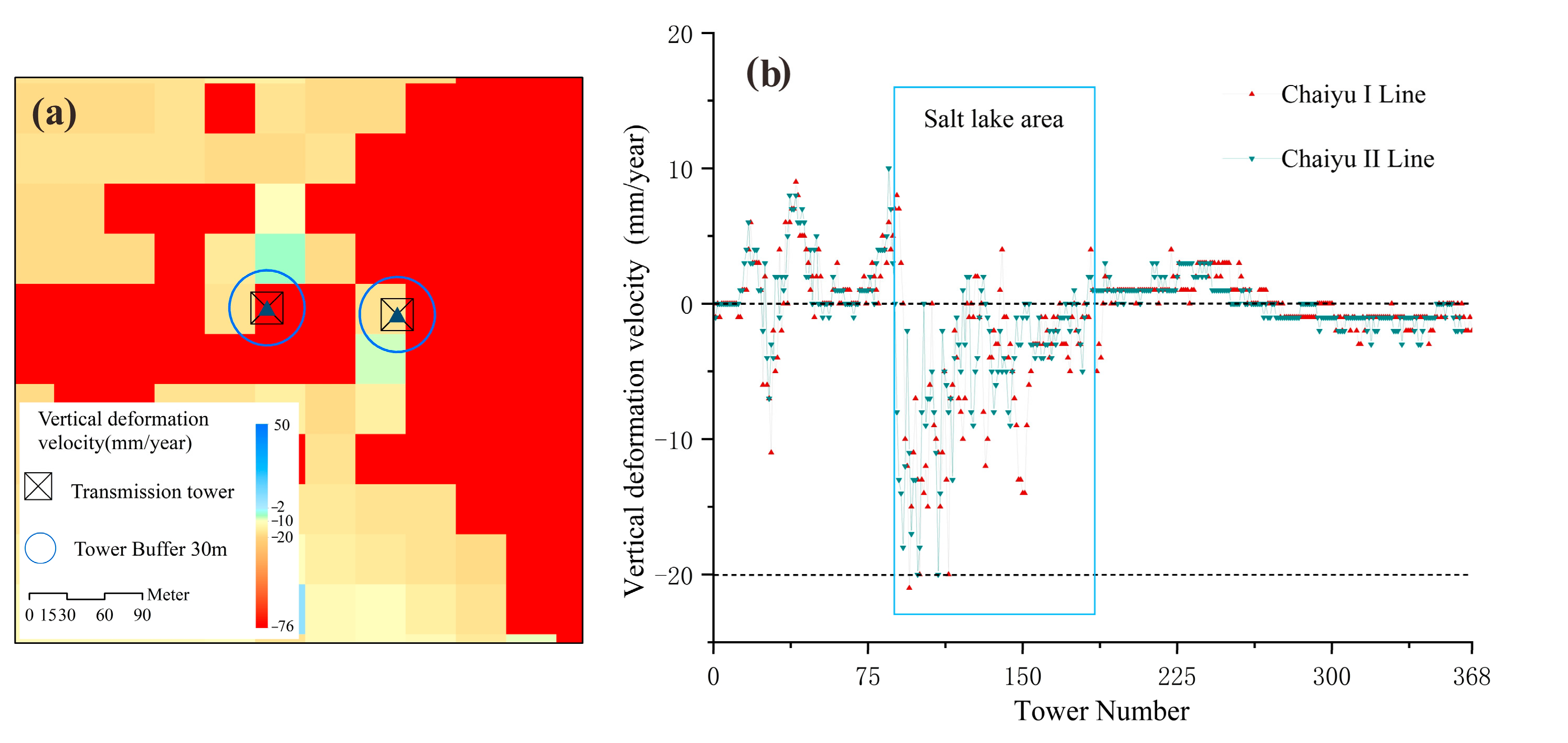
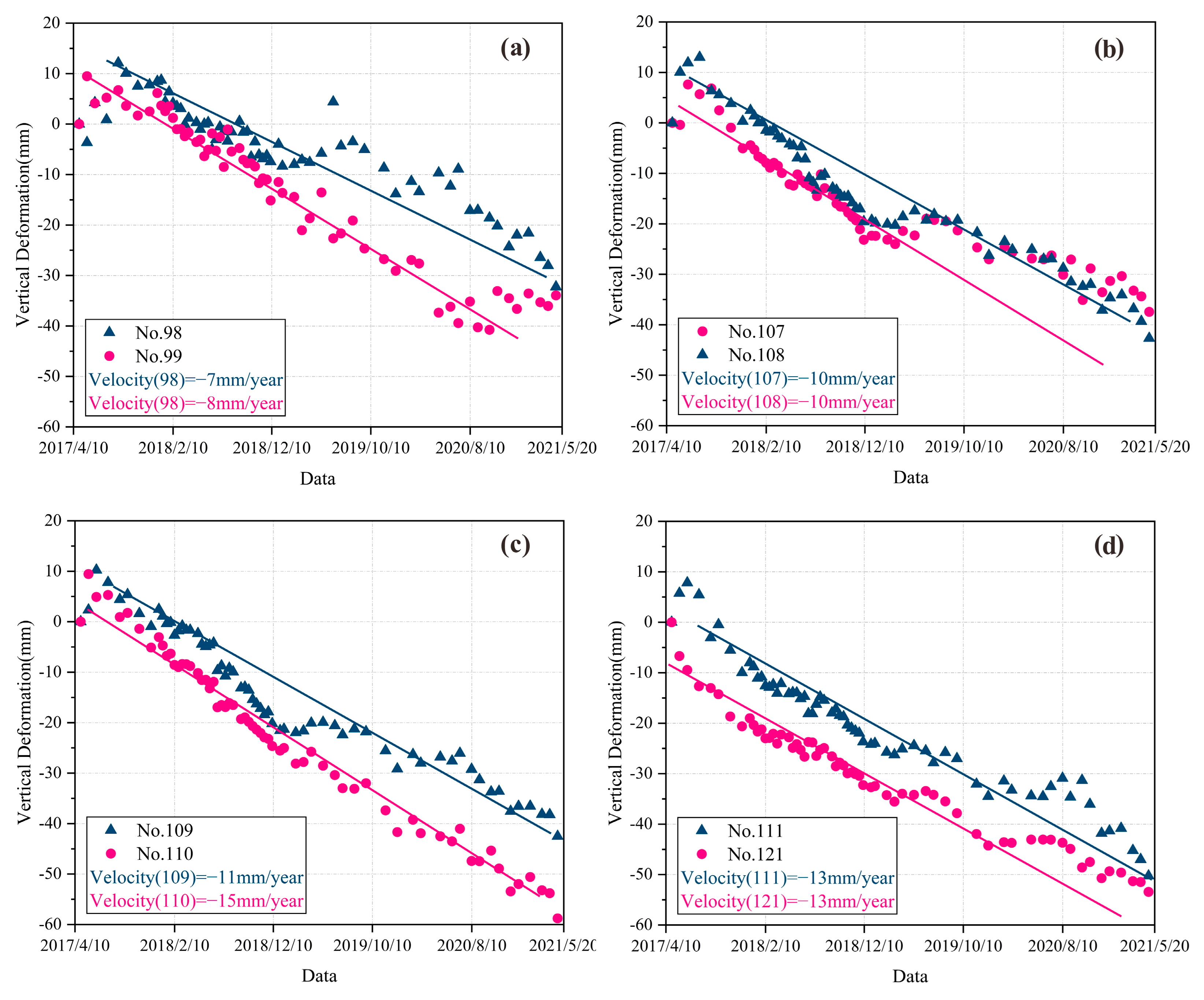
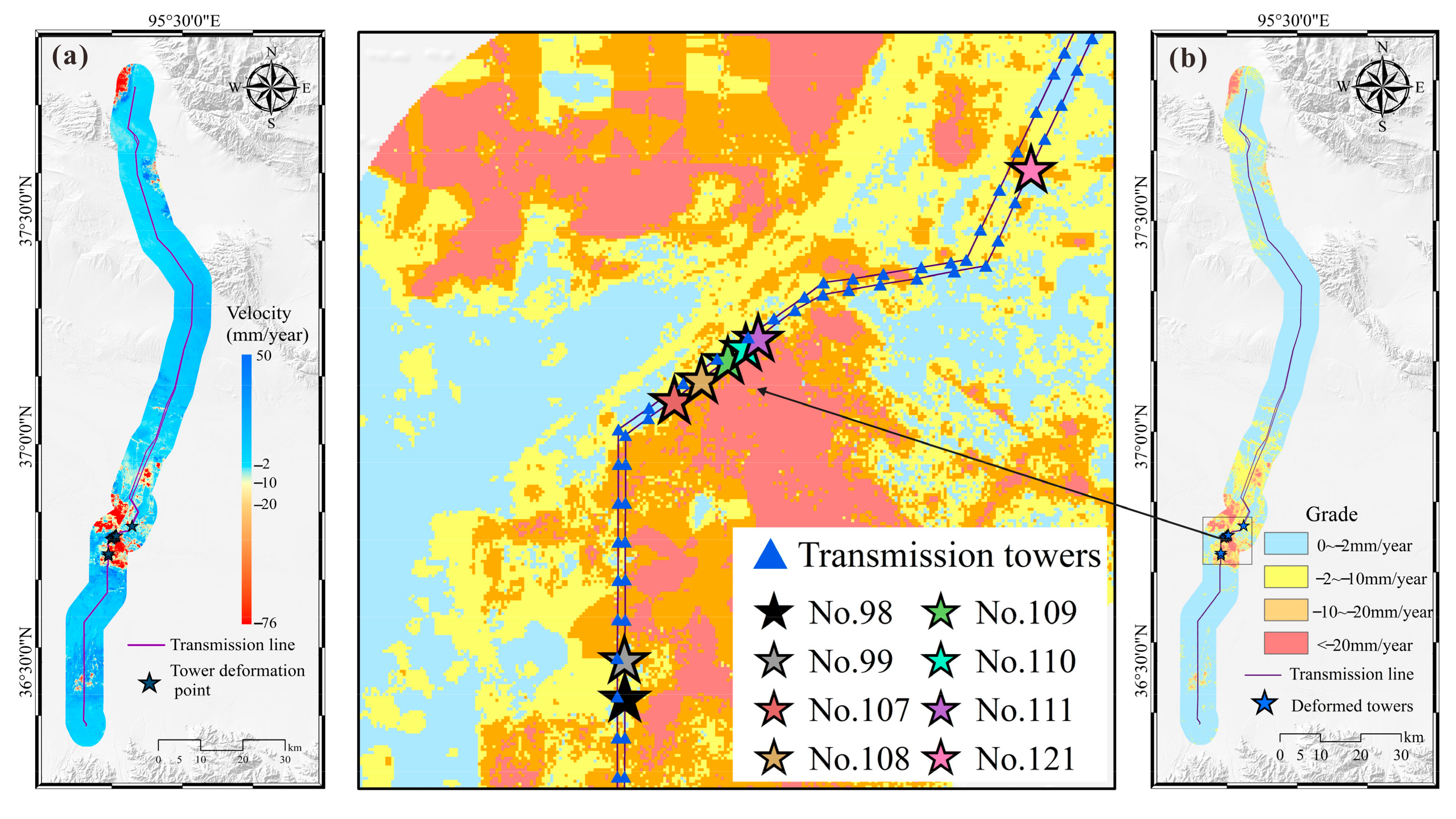
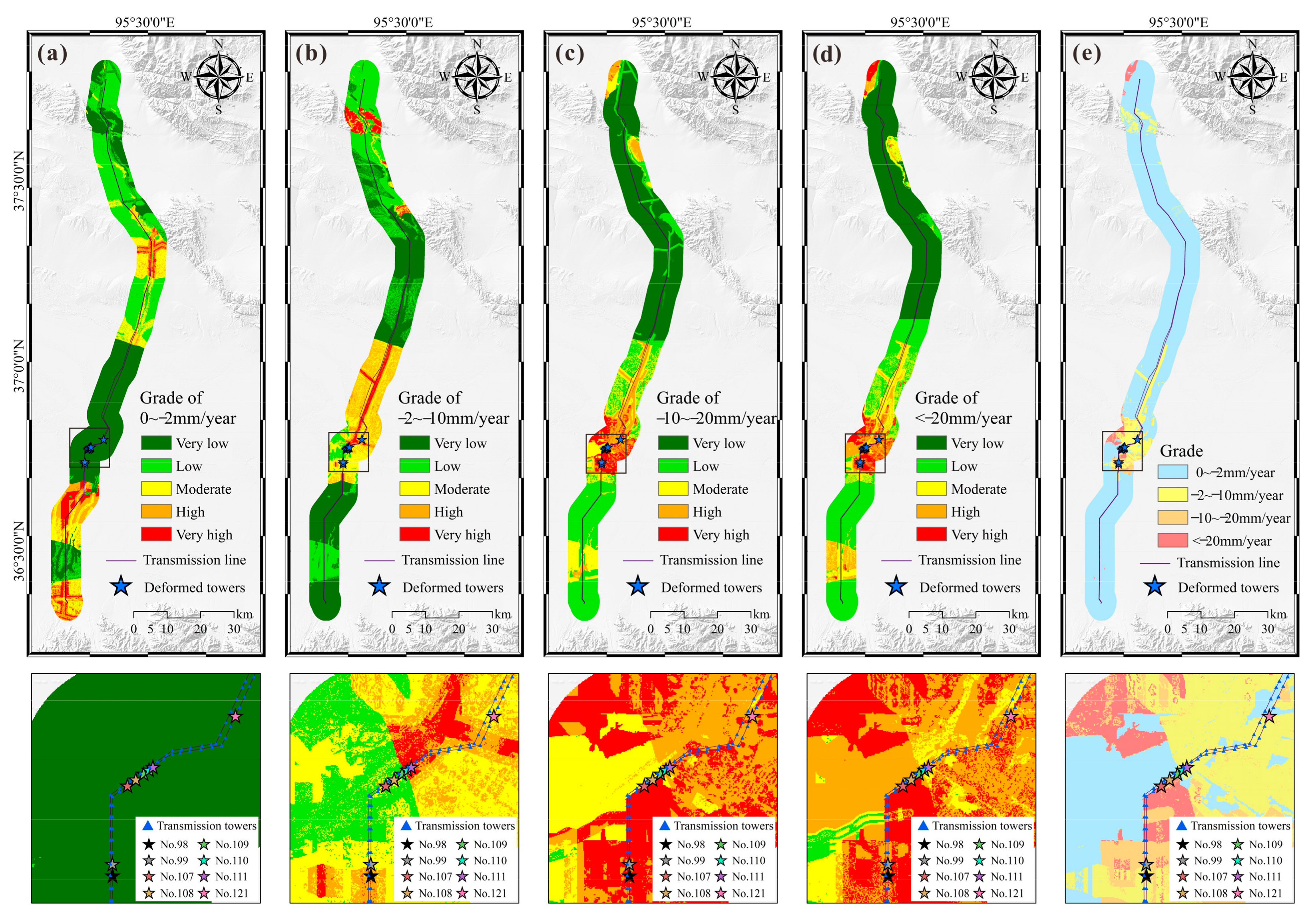

| No. | Acquisition Date (yyyy/mm/dd) | Days | B⊥(m) | No. | Acquisition Date (yyyy/mm/dd) | Days | B⊥(m) | No. | Acquisition Date (yyyy/mm/dd) | Days | B⊥(m) |
|---|---|---|---|---|---|---|---|---|---|---|---|
| 1 | 2017/4/28 | −360 | 73 | 24 | 2018/7/4 | 72 | 83 | 47 | 2019/9/21 | 516 | −55 |
| 2 | 2017/5/22 | −336 | 27 | 25 | 2018/7/16 | 84 | 32 | 48 | 2019/10/15 | 540 | 90 |
| 3 | 2017/6/15 | −312 | 12 | 26 | 2018/7/28 | 96 | 75 | 49 | 2019/11/20 | 576 | −41 |
| 4 | 2017/7/21 | −276 | 63 | 27 | 2018/8/9 | 108 | 71 | 50 | 2019/12/26 | 612 | 95 |
| 5 | 2017/8/26 | −240 | 12 | 28 | 2018/8/21 | 120 | −10 | 51 | 2020/1/7 | 624 | 88 |
| 6 | 2017/9/19 | −216 | 46 | 29 | 2018/9/2 | 132 | −78 | 52 | 2020/2/12 | 660 | 23 |
| 7 | 2017/10/25 | −180 | −40 | 30 | 2018/9/14 | 144 | 14 | 53 | 2020/3/7 | 684 | 21 |
| 8 | 2017/11/30 | −144 | 75 | 31 | 2018/9/26 | 156 | 59 | 54 | 2020/4/12 | 720 | −30 |
| 9 | 2017/12/24 | −120 | 81 | 32 | 2018/10/8 | 168 | 89 | 55 | 2020/5/6 | 744 | 99 |
| 10 | 2018/1/5 | −108 | 78 | 33 | 2018/10/20 | 180 | −3 | 56 | 2020/6/11 | 780 | 23 |
| 11 | 2018/1/17 | −96 | 95 | 34 | 2018/11/1 | 192 | −35 | 57 | 2020/7/5 | 804 | 123 |
| 12 | 2018/1/29 | −84 | 97 | 35 | 2018/11/13 | 204 | 7 | 58 | 2020/8/10 | 840 | −65 |
| 13 | 2018/2/10 | −72 | 19 | 36 | 2018/11/25 | 216 | 96 | 59 | 2020/9/3 | 864 | 91 |
| 14 | 2018/2/22 | −60 | 8 | 37 | 2018/12/7 | 228 | 61 | 60 | 2020/10/9 | 900 | −118 |
| 15 | 2018/3/6 | −48 | 19 | 38 | 2018/12/31 | 252 | 27 | 61 | 2020/11/2 | 924 | 71 |
| 16 | 2018/3/18 | −36 | 69 | 39 | 2019/1/12 | 264 | 9 | 62 | 2020/12/8 | 960 | −6 |
| 17 | 2018/3/30 | −24 | 72 | 40 | 2019/2/17 | 300 | 70 | 63 | 2021/1/1 | 984 | 54 |
| 18 | 2018/4/23 | 0 | 0 | 41 | 2019/3/13 | 324 | −19 | 64 | 2021/2/6 | 1020 | 39 |
| 19 | 2018/5/5 | 12 | 37 | 42 | 2019/4/6 | 348 | 23 | 65 | 2021/3/14 | 1056 | 55 |
| 20 | 2018/5/17 | 24 | 37 | 43 | 2019/5/12 | 384 | −9 | 66 | 2021/4/7 | 1080 | 26 |
| 21 | 2018/5/29 | 36 | 48 | 44 | 2019/6/17 | 420 | 95 | 67 | 2021/5/1 | 1104 | 99 |
| 22 | 2018/6/10 | 48 | 8 | 45 | 2019/7/11 | 444 | 18 | ||||
| 23 | 2018/6/22 | 60 | 7 | 46 | 2019/8/16 | 480 | 34 |
| Category | Factor | Source | Data Form | Data Scale |
|---|---|---|---|---|
| Topography | Slop | DEM SRTM from the Geospatial Data Cloud platform | Raster | 30 m |
| Plan curvature | DEM SRTM from the Geospatial Data Cloud platform | Raster | 30 m | |
| Profile curvature | DEM SRTM from the Geospatial Data Cloud platform | Raster | 30 m | |
| Geology | Lithology | National Geological Archives of China | Vector | 1:50,000 |
| Hydrology | Distance to River | Geospatial Data Cloud platform | Vector | 1:100,000 |
| Topographic Wetness Index (TWI) | DEM SRTM from the Geospatial Data Cloud platform | Raster | 30 m | |
| Human engineering activity | Distance to Road | Geospatial Data Cloud platform | Vector | 1:100,000 |
| Land use | Institute of Tibetan Plateau Research, Chinese Academy of Sciences | Raster | 30 m |
| Tower Number | Cumulative Vertical Deformation (mm) | Average Vertical Deformation Velocity (mm/Year) | Location |
|---|---|---|---|
| 98 | −29 | −7 | Figure 7a |
| 99 | −34 | −8 | Figure 7a |
| 107 | −41 | −10 | Figure 7b |
| 108 | −37 | −10 | Figure 7b |
| 109 | −44 | −11 | Figure 7c |
| 110 | −60 | −15 | Figure 7c |
| 111 | −50 | −13 | Figure 7d |
| 121 | −55 | −13 | Figure 7d |
| Conditioning Factor | Class/ Category | Ratio Each Class | Grade of −2~−10 mm/Year Ratio of Occurrence | Grade of −10~−20 mm/Year Ratio of Occurrence | Grade of <−20 mm/Year Ratio of Occurrence | Grade of−2~−10 mm/Year FR | Grade of−10~−20 mm/Year FR | Grade of<−20 mm/Year FR |
|---|---|---|---|---|---|---|---|---|
| Slope (degree) | 0~5 | 0.7774 | 0.6881 | 0.8438 | 0.8716 | 0.8852 | 1.0854 | 1.1212 |
| 5~20 | 0.1979 | 0.2396 | 0.1425 | 0.1133 | 1.2109 | 0.7203 | 0.5727 | |
| >20 | 0.0247 | 0.0722 | 0.0134 | 0.0151 | 2.9217 | 0.5543 | 0.6098 | |
| Profile curvature | −0.2 | 0.0770 | 0.1050 | 0.0836 | 0.0825 | 1.3647 | 1.0871 | 1.0725 |
| −0.2~0 | 0.5006 | 0.4615 | 0.5184 | 0.5325 | 0.9219 | 1.0356 | 1.0637 | |
| 0~0.2 | 0.3461 | 0.3293 | 0.3282 | 0.3259 | 0.9513 | 0.9483 | 0.9414 | |
| >0.2 | 0.0763 | 0.1042 | 0.0697 | 0.0591 | 0.3655 | 0.9129 | 0.7746 | |
| Plan curvature | <−1 | 0.0694 | 0.0901 | 0.0716 | 0.0714 | 1.2992 | 1.0312 | 1.0283 |
| −1~0.01 | 0.5646 | 0.5215 | 0.5960 | 0.6054 | 0.9237 | 1.0554 | 1.0722 | |
| 0.01~0.02 | 0.2944 | 0.2870 | 0.2721 | 0.2653 | 0.9746 | 0.9240 | 0.9011 | |
| >0.02 | 0.0716 | 0.1013 | 0.0604 | 0.0580 | 1.4160 | 0.8450 | 0.8097 | |
| Lithology map | Chemical deposits | 0.2442 | 0.5428 | 0.6927 | 0.5234 | 2.2225 | 2.8363 | 2.1433 |
| Marsh sediment | 0.0864 | 0.0191 | 0.0304 | 0.0437 | 0.2211 | 0.3521 | 0.5059 | |
| Lake sediments | 0.0336 | 0.0386 | 0.1600 | 0.3108 | 1.1479 | 4.7637 | 9.2528 | |
| Flood deposits | 0.2242 | 0.0635 | 0.0734 | 0.1108 | 0.2834 | 0.3276 | 0.4944 | |
| Alluvial deposits | 0.1218 | 0.1108 | 0.0386 | 0.0102 | 0.9098 | 0.3169 | 0.8369 | |
| aeolian deposits | 0.0469 | 0.0110 | 0.0048 | 0.0010 | 0.2352 | 0.1028 | 0.0214 | |
| Extremely hard rock | 0.1927 | 0.0783 | 0 | 0 | 0.4060 | 0 | 0 | |
| hard rock | 0.0501 | 0.1359 | 0 | 0 | 2.7146 | 0 | 0 | |
| Distance to river map (m) | 0~300 | 0.0430 | 0.0389 | 0.0895 | 0.0841 | 0.9054 | 2.0806 | 1.9561 |
| 300~600 | 0.0407 | 0.0289 | 0.0780 | 0.0818 | 0.7009 | 1.9181 | 2.0122 | |
| 600~900 | 0.0702 | 0.0424 | 0.1065 | 0.1275 | 0.6048 | 1.5170 | 1.8171 | |
| >900 | 0.8641 | 0.8897 | 0.7260 | 0.7065 | 1.0515 | 0.8581 | 0.8350 | |
| TWI | <6 | 0.1687 | 0.2157 | 0.0930 | 0.0694 | 1.2788 | 0.5507 | 0.4112 |
| 6~13 | 0.4323 | 0.3843 | 0.3974 | 0.4016 | 0.8890 | 0.9194 | 0.9290 | |
| 13~25 | 0.1364 | 0.1187 | 0.1381 | 0.1454 | 0.8703 | 1.0119 | 1.0660 | |
| >25 | 0.2626 | 0.2813 | 0.3716 | 0.3836 | 1.0711 | 1.4151 | 1.4608 | |
| Distance to road map (m) | 0~400 | 0.1547 | 0.6080 | 0.2163 | 0.1606 | 3.9294 | 1.3980 | 1.0380 |
| 400~800 | 0.1295 | 0.1715 | 0.1437 | 0.1771 | 1.3240 | 1.1095 | 1.3671 | |
| 800~1200 | 0.1157 | 0.1116 | 0.1265 | 0.1241 | 0.9646 | 1.0932 | 1.0727 | |
| >1200 | 0.6003 | 0.1090 | 0.5135 | 0.5382 | 0.1814 | 0.8554 | 0.8966 | |
| Land-use map | Residential | 0.0288 | 0.0248 | 0.0272 | 0.0288 | 0.8602 | 0.9465 | 0.9995 |
| Vegetation | 0.1115 | 0.0852 | 0.1816 | 0.2465 | 0.7641 | 1.6286 | 2.2099 | |
| Water | 0.0049 | 0.0084 | 0.0026 | 0 | 1.7254 | 0.5241 | 0 | |
| Bare | 0.7760 | 0.7336 | 0.2509 | 0.1191 | 0.9455 | 0.3234 | 0.1535 | |
| Saltern | 0.0789 | 0.1480 | 0.5376 | 0.6056 | 1.8765 | 6.8183 | 7.6803 |
| Raster FID | Grade of 0~−2 mm/Year | Grade of −2~−10 mm/Year | Grade of −10~−20 mm/Year | Grade of <−20 mm/Year | The Maxmium Susceptibility Value |
|---|---|---|---|---|---|
| 1 | 0.998 | 0.137 | 0.282 | 0.514 | Grade of 0~−2 mm/year |
| 10623 | 0.635 | 0.876 | 0.752 | 0.631 | Grade of −2~−10 mm/year |
| 146269 | 0.463 | 0.568 | 0.625 | 0.534 | Grade of −10~−20 mm/year |
| 501516 | 0.528 | 0.324 | 0.685 | 1 | Grade of <−20 mm/year |
| … | … | … | … | … | … |
Publisher’s Note: MDPI stays neutral with regard to jurisdictional claims in published maps and institutional affiliations. |
© 2022 by the authors. Licensee MDPI, Basel, Switzerland. This article is an open access article distributed under the terms and conditions of the Creative Commons Attribution (CC BY) license (https://creativecommons.org/licenses/by/4.0/).
Share and Cite
Jin, B.; Yin, K.; Li, Q.; Gui, L.; Yang, T.; Zhao, B.; Guo, B.; Zeng, T.; Ma, Z. Susceptibility Analysis of Land Subsidence along the Transmission Line in the Salt Lake Area Based on Remote Sensing Interpretation. Remote Sens. 2022, 14, 3229. https://doi.org/10.3390/rs14133229
Jin B, Yin K, Li Q, Gui L, Yang T, Zhao B, Guo B, Zeng T, Ma Z. Susceptibility Analysis of Land Subsidence along the Transmission Line in the Salt Lake Area Based on Remote Sensing Interpretation. Remote Sensing. 2022; 14(13):3229. https://doi.org/10.3390/rs14133229
Chicago/Turabian StyleJin, Bijing, Kunlong Yin, Qiuyang Li, Lei Gui, Taohui Yang, Binbin Zhao, Baorui Guo, Taorui Zeng, and Zhiqing Ma. 2022. "Susceptibility Analysis of Land Subsidence along the Transmission Line in the Salt Lake Area Based on Remote Sensing Interpretation" Remote Sensing 14, no. 13: 3229. https://doi.org/10.3390/rs14133229
APA StyleJin, B., Yin, K., Li, Q., Gui, L., Yang, T., Zhao, B., Guo, B., Zeng, T., & Ma, Z. (2022). Susceptibility Analysis of Land Subsidence along the Transmission Line in the Salt Lake Area Based on Remote Sensing Interpretation. Remote Sensing, 14(13), 3229. https://doi.org/10.3390/rs14133229







